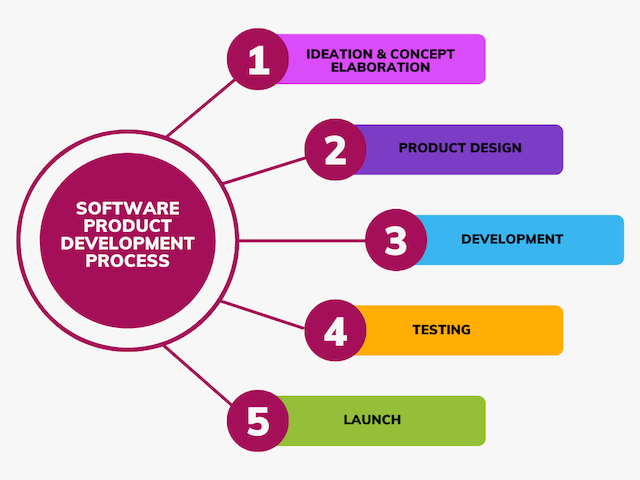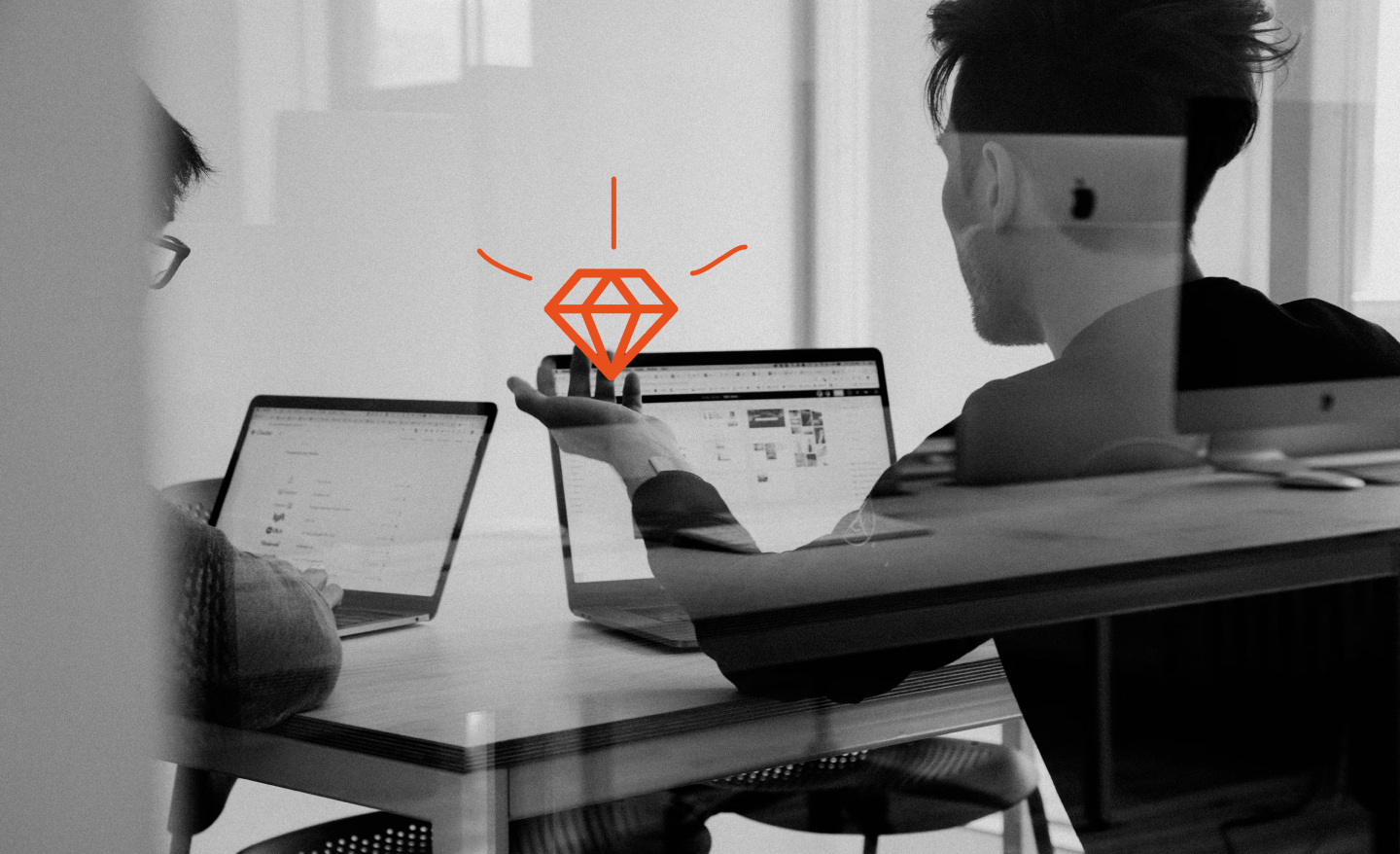
How to Start a Software Product Development Process

The beginning is always the hardest part. When it comes to product development, a perfect start for companies can be sizing up the amount of work awaiting on this journey. Moreover, it’s essential to follow a set of clear steps for developing a high-quality product that meets your business goals and requirements.
If you want to set your product development on the right track, this post is for you. We will go over the main steps, focusing on how to start your software product development process and the steps it entails, complementing it with a software development process flow diagram and examples of common approaches. Let’s dive in!
Software product development process: Key steps
In a nutshell, the software product development process has 6 key stages, going through which the company creates the concept of the product and delivers it to the market.
A clear process is the best way to avoid chaos. Thanks to it, product owners can divide such an enormous task as product development into stages and organize the workflow properly, with vivid outcomes at each step. Let’s review the steps of the software product development process.
READ ALSO: 5 Key Benefits of Custom Software Development
Ideation
You dive into the software product development process to build a great product, enter the market and start cashing in. But before you do that, it’s essential to give shape to your idea. With that in mind, your team should sit down to brainstorm ideas, focusing on the market segment you want to conquer. You may want to consider the following questions:
- Who is going to use your product? It’s essential to define your target audience to develop the right kind of product keeping in mind the needs of your potential customers and their pain points.
- Are there any solutions similar to the one you aim to develop? Your team needs to have an understanding of potentially competing products, including their strengths and weaknesses. This will help you define how you can stand out in the market.
- What functions should your product have? Before diving into the design and development of your product, it’s best to have a vision (at least, in broad strokes) of the product functions and how they can help your target audience achieve their goals when they interact with your product.
- What are the strengths and weaknesses of your idea? The beginning of the software product development process is a good point to define potential risks and capabilities as well as generate unique marketing value for your product.
One part that can be challenging during the ideation stage is creating and documenting the requirements for the product. The document should reflect your idea and give your team an understanding of your vision, goals, and product functions.
Concept elaboration
After you complete the initial analysis and the product begins to shape out, the next step of the software product development process is to work on the concept of the product. You may want to go over the following aspects:
Marketing strategy: How you are going to market your product? To answer this question, it’s essential to carry out a business analysis and see where your competitors stand in terms of their strategy. The goal of this is to write a clear and precise roadmap for your product.
Value proposition: Why your customers should choose your product over others? Determine the pain points it solves for your target market and define your value proposition that will make your product outshine the competing ones.
Success metrics: How do you know your product is successful? Define success metrics you will track to see if your strategies are effective. These may include customer acquisition costs, monthly recurring revenue, total revenue, etc.
After you elaborate on the concept of your product, time for the next stage of the software product development process – validating your idea with the help of a prototype.
READ ALSO: How to Outsource Software Development Projects Successfully?
Product design
Product design is an essential stage of the software product development process, during which your team will create the software architecture and design a user interface.
This part of the software product development process can also be dedicated to creating a prototype of your product: A version of your product that entails only essential features. The goal of a prototype or Minimum Viable Product (MVP) is to introduce your product idea to the target audience before you dive into full-fledged development. Thanks to an MVP, you can also collect all the required information for further development. The rest of the functions can be added at later stages of development.
Development
The next stage of the software product development process is programming, during which software developers write code. The goal at this step is to keep the balance between the speed of development and the quality of the final product. When the code is ready, the development team passes it on to the testing team for evaluation.
READ ALSO: How to Hire Developers for a Startup
Testing
To make a splash on the market, the product should be of the highest quality. So, the next step of the software product development process is to ensure the codebase produced by developers is up to standard. Even if you have what may seem like a perfect product you still need to release a beta version to let users test it and identify potential errors. After the testing period is over, your team should correct all the bugs, so your product is polished for the big day of launch.
Launch
After the product is tested, it is time to launch it: The team releases the product and markets it to the target audience. At this step, marketing and Sales teams step in to ensure that the customers can access it and address any questions or concerns they might have.

Software development process flow diagram
What does a custom software development process look like? Common methodologies
A custom software development process at your company can be designed in a way that allows you to release the entire product at once (as in Waterfall) or divide it into parts and release them separately (as in Agile). Waterfall and Agile are known as common approaches to the software product development process.
Waterfall
Also known as a linear approach, Waterfall is a traditional approach to the software product development process. The peculiarity of this model for a custom software product development process is that the completion of one step is required before moving on to the next one.
The software development process example for the Waterfall model will look like this:
- Requirements gathering: The team collects requirements from the stakeholders and documents Software Requirements Specifications or SRS.
- Design: The SRS is the foundation for designing and developing the software architecture.
- Development: In this stage, developers write code based on the SRSs.
- Quality Assurance: After code implementation is done, it’s tested by quality assurance experts aimed at finding potential bugs. The improved software is tested again till all errors are ironed out.
- Deployment and maintenance: During these stages, the approved code is delivered from developers to users. At the maintenance step, developers monitor the environment for potential problems in code.
Agile
Agile is also known as an iterative software development process that helps teams deliver products faster by dividing the work into small, but consumable, modules or iterations.
A common question among companies developing products is “What is an iterative software development process designed to do?” All iterations of the product include such processes as requirements gathering, design, implementation, and testing. Each subsequent iteration adds functions to the previous one. The iterative software development process continues till the product is completed according to the requirements.
The software development process example for this model will look like this:
Iteration 1: Requirements – Design – Development – Testing – Implementation
Iteration 2: Requirements- Design – Development – Testing – Implementation
Iteration 3: Requirements – Design – Development – Testing – Implementation
As opposed to the Waterfall methodology, testing is a part of each step in Agile development: After an iteration is complete the product owners review it to compile detailed feedback, which will be a stepping stone for the next version of the product.
READ ALSO: Benefits of Agile Nearshore Development
Summary
Ideation and concept elaboration are the initial steps that will help you set off a successful software product development process. Along the way, your product will undergo design, development, testing, and launch.
The most important element of the product journey is the team behind it. If you’re looking for skilled software developers, we at nCube can help. We can source tech talent from Eastern Europe and LATAM with experience in building products, in the same way we did for doTerra, Life360, CrossEngage, and other product companies. Contact us to learn more about our remote cooperation model.
Recommended articles


